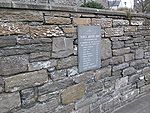- HMS Jervis Bay
-
Career 
Name: HMS Jervis Bay Builder: Vickers Limited, Barrow-in-Furness Launched: 1922, as SS Jervis Bay Acquired: August 1939 Commissioned: October 1940 Fate: Sunk, 5 November 1940 General characteristics Type: Armed Merchant Cruiser Displacement: 14,164 long tons (14,391 t) Length: 549 ft (167 m) Beam: 68 ft (21 m) Draft: 33 ft (10 m) Speed: 15 knots (28 km/h; 17 mph) Complement: 254 Armament: • 7 × 6 in (152 mm) Mk. VII guns
• 2 × 3 in (76 mm) anti-aircraft gunsHMS Jervis Bay was a British liner later converted into an Armed Merchant Cruiser, pennant F40. She was launched in 1922 and sunk on 5 November 1940 by the German pocket battleship Admiral Scheer.
The ship was originally the Aberdeen & Commonwealth Line steamer Jervis Bay named after the Australian bay (the line named all of its ships after bays). She had been taken over by the Royal Navy in August 1939 on the outbreak of the Second World War and hastily armed with a few World War I vintage 6-inch guns. She was initially assigned to the South Atlantic station before becoming a convoy escort in May 1940.
She was the sole escort for 37 merchant ships in Convoy HX-84 from Halifax, Nova Scotia to Britain, when the convoy encountered the Admiral Scheer. The Captain of Jervis Bay, Edward Fegen, ordered the convoy to scatter, and set a course straight towards the German warship to draw its fire, guns blazing.[1] The Jervis Bay was hopelessly out-gunned and outranged by the 28 cm guns of the German ship. Even so, Fegan and his crew fought on until their ship was set ablaze and sunk 755 nautical miles (1,398 kilometres) south-southwest of Reykjavík. Captain Fegen went down with his ship.[2] However, although Admiral Scheer went on to sink five merchant ships out of the convoy, Jervis Bay's sacrifice bought enough time for the convoy to scatter, and the remaining ships escaped. Sixty-five survivors from Jervis Bay were picked up by the neutral Swedish ship Stureholm.
Captain Fegen was awarded a posthumous Victoria Cross as a result of this action. The citation for the Victoria Cross reads "Valour in challenging hopeless odds and giving his life to save the many ships it was his duty to protect."
There is a monument to Jervis Bay at Albouy's Point, in Hamilton, Bermuda. Bermuda was a formation point for trans-Atlantic convoys in both World Wars. There is a monument to Captain Fegen and the crew of Jervis Bay at Ross Memorial Park in Saint John, New Brunswick, Canada. This is the port where she was refitted for war service in the summer of 1940. In 2006 the town of Wick erected a plaque to the Caithness members who died in the sinking of the ship. The ship was crewed extensively from Caithness, and Wick in particular.
There was also a monument in London. The main room of the Merchant Navy Hotel (closed, 2002) was known as the "Jervis Bay Room", and included a display detailing the action. It was the custom for everyone entering the room to salute the display.
The ship is also featured as a model in Scarborough's "Naval Warfare" holiday show which takes place in the summer at Peasholm Park, in the show the ship fights off an enemy battleship and submarine.
See also
External links
Sources
- Ralph Segman and Gerald Duskin, If the Gods are Good: The Epic Sacrifice of HMS Jervis Bay (Naval Institute Press, 2004)
References
Categories:- Auxiliary cruisers of the Royal Navy
- World War II cruisers of the United Kingdom
- World War II ships of the United Kingdom
- Barrow-built ships
- World War II shipwrecks in the Atlantic Ocean
- 1922 ships
- Maritime incidents in 1940
Wikimedia Foundation. 2010.

